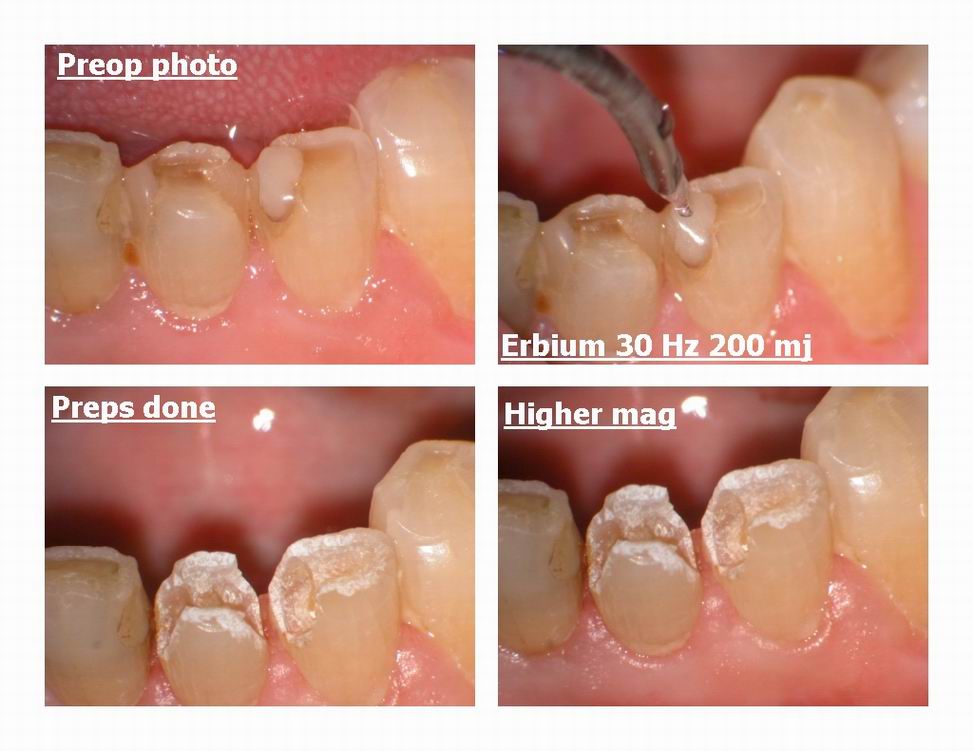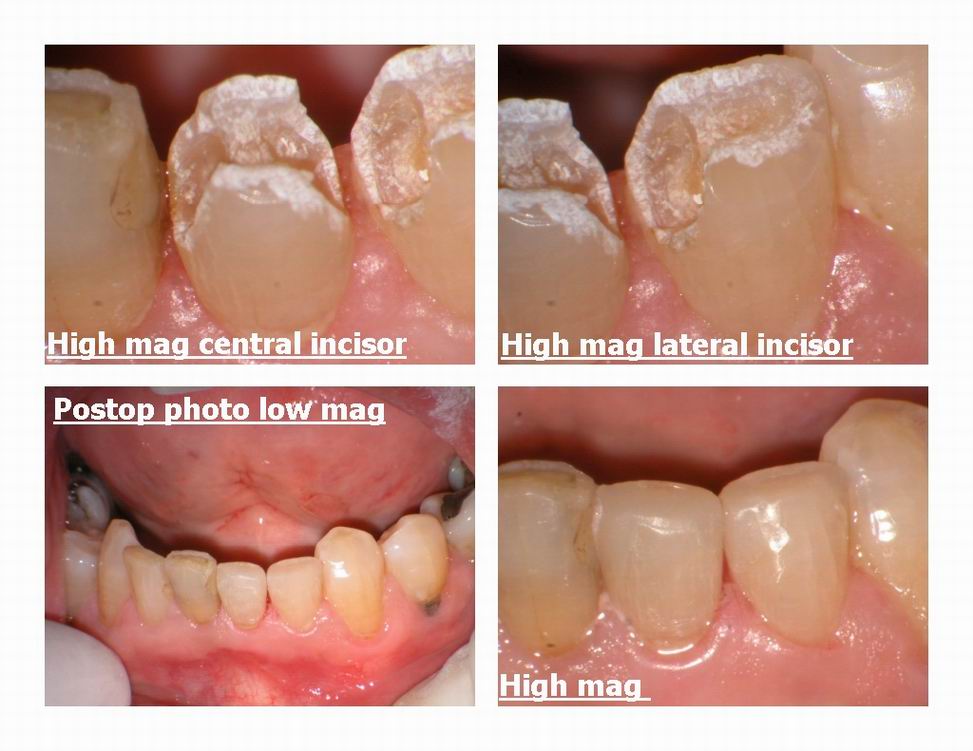Forums › Laser Treatment Tips and Techniques › Hard Tissue Procedures › Another simple case
- This topic is empty.
-
AuthorPosts
-
Glenn van AsSpectatorHi folks: Here is another simple case I did this week ( got lots of cases done this week dont know why) and it was a lower incisors case.
No anesthetic, patient rated pain as 0/100. Wedges were worst part he said.
Patient watched whole procedure on TV……was riveting he said.
Desensitized with Mark Colonna modified Delight technique…..high wattage defocussed for 2 mins
Full power for resins of which the mesial on the central was simple ( resin) and the others were most likely silicates or some old resin as they were a tough time.
Got them out and replaced with Palfique shade A3…..nice material.
Spherical particles and looks nice at end.
Just a simple thing like this makes huge impression on patient.
Took around 50 mins I think with photos.
Cya
Glenn


Glenn van AsSpectatorPs Patient now wants to do other side ( he only wanted the left side done before)……….
Thats the power of the laser and scope.
Glenn
BenchwmerSpectatorGlen,
I always wonder about the emphasis on hard tissues laser user on no anesthia. If I was doing this case with Hi Speed handpiece, I wouldn’t use any local and would still get no pain. Retreating anterior composites of this age, occlussal wear, there is no response.
Using the OpusDuoE, where I can vary Hertz, I have only had to stop and give local a handfull of times in cavity preparation/ caries removal.
Do you really need to pre-lase, expose the teeth to added energy, take the added time?
The results and preparation technique are wonderful, but why the extra laser exposure?
Jeff
Glenn van AsSpectatorJeff you always ask interesting questions!
If this is the patients first attempt with lasers then they will be much more apprehensive and in addition they will be difficult to calm down if they feel something.
THe extra laser time does NOTHING physically to the tooth at all, it only takes 2 mins of time and gives me a little more comfort. I have done Class Vs with this technique in the lower anterior at 30 Hz and 140 mj and the patient felt nothing during the preps. At the very end after polishing the resins etc, I noticed one spot that wasnt well done. The patient was relased at 30 Hz and 70 mj or half the energy I used before and the JUMPED ……..Ouch that hurts.
I hadnt relased for the two minutes and the energy was half of what I used before. She was very jumpy after that until I finished.
As for the Delight, it too has multiple and higher hertz settings than the Opus which I believe only has a maximum setting of 12 Hz and a higher maximum of 1000mj.
You need to use the higher energy settings because if you measure the energy coming out of the hollow wave guide it will only be something like 20 % of the energy that starts out from the box.
THe repetition rates available for the Delight erbium include 3, 10, 20, 25 and 30 Hz which give far more range and variability than any of the other lasers.
Correct me if I am wrong but the Opus is 3-12 hz isnt it?
The Biolase is 20 Hz.
To be honest , I rarely use anything less than 30 Hz on hard tissue except in deep preps as it slows down. For soft tissue and apthous ulcers I will vary the Hz rate more.
Finally, I am of the opinion that pre-existing resins and their age are of insignificance to the sensitivity of the patient. Existing depth of the restorations, patient age (pulp size) and patient individuality, as well as number of previous laser preparations seem to be bigger clues for me as to the potential sensitivity of the patient.
I do find that the age of the restorations may determine how easy they are to get out of the mouth with the laser. Higher filled resins and silicates are tougher to get out with the laser compared to microfills or sealants when using the same energy settings.
When I used the slowspeed to remove some Dycal (it wont come out with the laser, when I view it with the scope), the patient felt quite a bit.
In closing , alot of my thoughts come from seeing how the laser interacts with tissue at 10X power and above. Your experiences may of course be different and it is great to get alternative viewpoints.
Thanks for your post Jeff……..
Glenn
SwpmnSpectatorQUOTECorrect me if I am wrong but the Opus is 3-12 hz isnt it?I believe the Hz range on the OpusDuoE is 7 to 20 pps.
Very nice composites.
Al
dkimmelSpectatorGlenn, I agree with Jeff about being able to restore those teeth with a high speed without anesthia. You are right on by spending that extra time for patient management. If it is a first time patient it is more then worth the extra effort to get them used to the sound and water spray. They really do not know what to expect. The true phobic just knows you are going to hurt them.
Nice case!!!
DAvid
Glenn van AsSpectatorDave I dont know if this case could have been done without anesthetic. The patient is in their late 40s.
But that is neither here nor there.
The psychological benefits are one thing but I honestly can say that I know that the laser will “numb up the tooth ” if its used for a couple of minutes before you start.
The true phobic isnt the one that lasers are great for……if they are that worried , it wont matter what you use.
Alan…..thanks , great to know that the Opus has that option. The Hoya has a lower and higher range but its nice to know that Opus has a range to use. Thanks for the compliment
Cya
Glenn
ASISpectatorHi Glenn,
The key is patient felt nothing in terms of discomfort. And more importantly, he is requesting further treatment.
Generally, not many patients will ask for more if done traditionally with injection and handpiece. I have always said to many that even if dentistry is free, people won’t likely be lining up at the door.
Now with the use of laser and scope, that’ll be a different story, if it was free!
Nice handling and documentation again.
Andrew
Robert Gregg DDSSpectatorHi All,
Nice discussion.
To take a different perspective–for the analgesic effect to work–some sort of effect is taking pace in the tissues of the pulp. The question with erbium (which is highly absorbed in water, HA and collagen) is how is the energy of 2.8 or 2.9 getting into the pulp? Scatter?
Or is the erbium wavelength involved at all. Maybe a different spectral band that is emitting is involved (no laser is truly monochromatic–even though we repeat that in our basic physics).
Just my early morning musings. I mean, we’ve been doing this with pulsed Nd:YAG for 14 years (then picking up the high speed or continuing to lase if a Class 5 or composite), but we assumed it was due to the wavelength’s deep penetrating properties. Maybe not!
Bob
PatricioSpectatorHi Group,
I find most of the reasons for lasing on the anterior teeth of the older patient have to do with building trust and confidence and getting the patient in the “zone” of relaxation. I would say it is common for me to laser at 1.50 W and 11%A and 7%H20 for 30 seconds, maybe 45 seconds, if I believe the patient to be more sensitive. I find this setting to be a comfortable beginning for me and I believe more acceptable for our patient than 5.5/w or so. Then I test the tooth prep site at 1.50 W if all is well I will increase to 4W and maybe more. If there is a second or third tooth I rarely lase before I begin and most of the time the patient continues in a comfort mode. One can certainly use the HS but most patients will tell you they prefer the laser. The electric seems to be better tolerated than the air turbine. Success is about what is best for me, my staff and ultimately, patient enthusiasm for treatment and service received.
Pat
-
AuthorPosts
